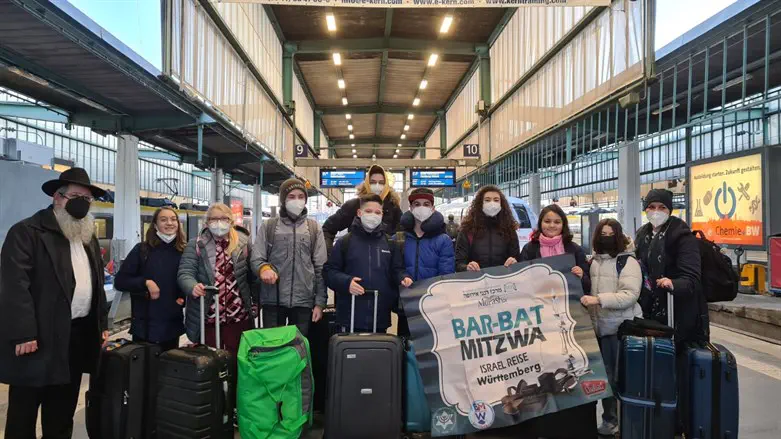
As he shuddered with tears in his eyes, Ariel from Hungary clutched the tallit (prayer shawl) and tefillin (phylacteries) bag he received moments before standing in front of the Western Wall. His counselor, Rabbi Asher Feit, ran over to him.
"Are you alright?" he asked. "Yes, yes," Ariel answered. With his eyes filled with tears, he added, "It's just that I need help putting on this tefillin. I'm so overwhelmed standing here at the most sacred place of the Jewish nation. My mother and father gave me a note to put in the Kotel (Western Wall - ed.), but I have to put on tefillin, and tallit and I don’t know what to do first."
The counselor patted his shoulder, calmed him down and reassured him. "Put on your tallit, let's help you put on tefillin, and we will pray together. We will hear the reading in the Torah of Rosh Chodesh (the new Jewish month) and then you can put the note in the Kotel."
Ariel calmed down and within minutes he was wrapped in his tallit and had donned his tefillin just like his 120 other friends, all bnei-mitzvah from Europe, who arrived on March 3rd to put on tefillin at the Kotel with the support of the Western Wall Heritage Foundation led by Rabbi Shmuel Rabinovitch, rabbi of the Western Wall and the Holy Sites of Israel. It was the conclusion of a seven-day trip to Israel, initiated by the MORASHA division of the Rabbinical Centre of Europe (RCE).
The Bar/Bat Mitzvah trip was intended to introduce the youth to the Land of Israel, which they learned and heard about in the various frameworks operated by the Rabbinical Centre of Europe (RCE) together with the European Jewish Association (EJA). This was the 13th year the trip has taken place, after two years in which it could not be held because of the coronavirus pandemic.
The youth came from Hungary, France, Estonia, Spain, Belgium, Germany, and the Netherlands, where some of them come from families who do not have a clue about Judaism. They visited many sites around the country and experienced the Land of Israel firsthand. In addition to tours and attractions, the youth experienced educational and social activities.
The staff of the Rabbinical Centre of Europe in the Morasha Division, led by the Vice President of the RCE, Rabbi Yossi Bainhaker, work among Jewish communities and especially small communities in Europe to strengthen Jewish identity for children and youth who do not have the privilege of a Jewish Shabbat or weekday, as they do not live in a Jewish environment. The flagship project is the trip to Israel which brings their learning to life.
Each group was accompanied by their community rabbi and a counselor fluent in their language.
The trip was designed to strengthen the youths' connection to Israel and was carefully planned to emphasize every part of the trip so that the youth could internalize the experience for the rest of their lives.
The gala event near the Kotel was the moment the youth eagerly waited for. The night before the event, the counselors were surprised to see that the children had difficulty falling asleep even though they were exhausted. When asked, the children explained that they were too excited to fall asleep.
Immediately after a light breakfast, the youth went out to the Kotel. Before entering the Western Wall plaza, musicians waited for them and greeted them with the songs for the month of Adar and Purim. Immediately afterwards, canopies were spread out and the boys and girls marched, in complete separation, to the Western Wall plaza. The excitement was visible on their faces. The musicians then accompanied them to the Western Wall plaza, where they said goodbye while blowing the shofar, which made their hearts tremble.
The group of girls went to pray by the women's section and the boys entered the men's section, where each of them was given a pair of tefillin, a tallit, and a special siddur (prayer book) donated by businessman Rami Levy. Immediately after wrapping themselves in a tallit and putting on tefillin with the help of the counselors and rabbis of the communities, Rabbi Avraham Abba Torezki, Secretary of the Rabbinical Council of Europe, stood up and read aloud the verses of Shema Yisrael. After that, the children prayed the Rosh Chodesh prayer, heard the reading of the Torah, and were thrilled when a huge tallit was spread over their heads during the Birkat Cohanim (the Priestly Blessing). Many of them were in awe.
"It's a spiritual experience that we'll take with us for life," they later said.
Thursday evening, a Bar/Bat Mitzvah celebration was held in collaboration with the Western Wall Heritage Foundation, with participation of rabbis and public figures, including Rabbi Yaakov David Schmahl, Dayan of the Shomrei Hadas community of Antwerp and a member of the Rabbinical Council; Rabbi Yirmiyahu Cohen, member of the Rabbinical Presidium of the RCE; Rabbi Shmuel Rabinovitch, rabbi of the Western Wall and the Holy Sites of Israel; Rabbi Elazar Simcha Weiss, Member of the Council of the Israeli Chief Rabbinate; Rabbi Moshe Ben Dahan, Rabbi of Madrid; Rabbi Menachem Mendel Gluchovsky, and Deputy Secretary of the Rabbinical Court of Chabad and rabbi of the Chabad community in Rehovot. Also attending were MK Rabbi Yitzhak Pindrus (United Torah Judaism); Rabbi Yaakov Halperin, Deputy Mayor of Jerusalem; Rabbi Maimon Avitan, rabbi of the "Rami Levy" chain; R. Mordechai (Moti) Sonenfeld, founder of the Danieli Foundation, who accompanies the RCE's activities throughout the year; philanthropist and businessman Rami Levy; and other public figures.
During the celebration, a quiz was held on concepts of Judaism and Torah, while presented by a pantomime performance that acted out various events from the Torah. The contestants demonstrated impressive knowledge and the end of the quiz the winners received valuable prizes.
Rabbi Ephraim Kamisar was the emcee, and he noted the great assistance provided by Nati Isaac, Director General of the Jerusalem and Heritage Ministry; Yaakov Hagoel, Chairman of the World Zionist Organization and Acting Chairman of the Jewish Agency for Israel; Rabbi Eliyahu Eidelkop, Director of the European Jewry Development Fund; and Mr. Sar Shalom Jerby, Director of the JNF Education Division. Singer Simcha Friedman and keyboard player Leibl'e Lipsker were in charge of the dancing and joy.
Rabbi Menachem Margolin, Chairman of the RCE and UJA, said as the youth returned to their countries, "The trip is an essential part of the Rabbinical Centre of Europe's activities. The RCE thoroughly emphasizes the issue of Jewish education and prevention of assimilation in the Jewish communities."
Rabbi Arie Goldberg, Director General of the RCE, described with great emotion the special Shabbat (Sabbath) that the boys kept in Jerusalem. For many of them it was first Shabbat they kept from beginning to end.
"It was a spectacular sight to see their thirst to know what it means to be a Jew," he said, adding, "It was a costly trip with heavy responsibilities. Even so, as soon as the COVID restrictions were lifted, we responded to the request of many rabbis from all over Europe who wanted to bring youth from different countries and cities to participate in the powerful journey."
Rabbi Yosef Bainhaker, Vice President of the RCE, said: "The trip is logistical challenge. Every detail must be planned meticulously in advance. Thank G-d the trip was flawless. As we said goodbye to the children, who expressed their thanks and gratitude, I told them that all the effort was worth it seeing them waiting in anticipation for their next visit to Israel."
